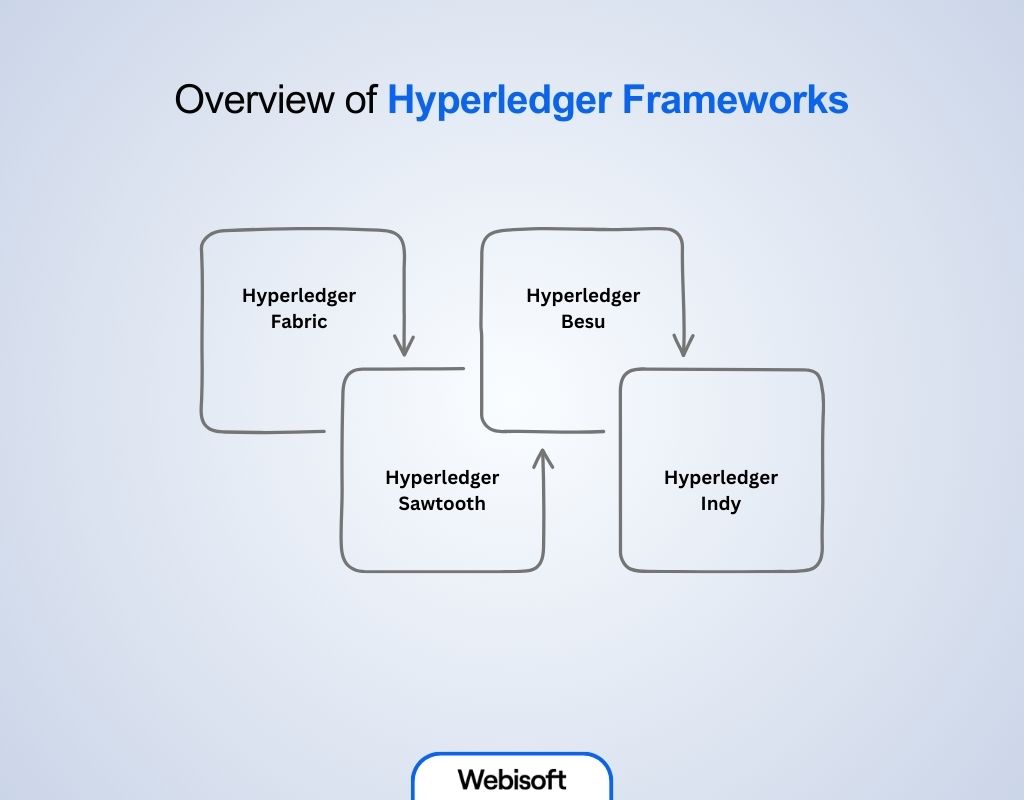Not all blockchains work the same way. If you’re stuck in Hyperledger vs blockchain, you probably have a few big questions:
- Do you need a fully open network or a private, controlled one?
- Is speed more important than full transparency?
- Does your project need cryptocurrency, or do you prefer a system without tokens?
Public blockchains, like Bitcoin and Ethereum, are open to anyone. They create trust without needing a central authority. But they can be slow and expensive. Hyperledger, on the other hand, is built for businesses that need security, privacy, and better control over data.
Choosing the wrong system can lead to high costs, inefficiencies, or even legal issues. We’ll break down the key differences—security, scalability, and how they handle transactions. By the end, you’ll know which one fits your business best.
Contents
- 1 Hyperledger vs Blockchain: A Quick Comparison Table
- 2 What is Hyperledger?
- 3 What is Blockchain?
- 4 Key Differences Between Hyperledger vs Blockchain
- 4.1 1. Permissioned vs. Permissionless Networks
- 4.2 2. Transparency and Privacy
- 4.3 3. Consensus Mechanism
- 4.4 4. Scalability and Performance
- 4.5 5. Use of Cryptocurrency
- 4.6 6. Smart Contracts and Enterprise Integration
- 4.7 7. Governance and Control
- 4.8 8. Purpose and Use Case
- 4.9 9. Transaction Finality
- 4.10 10. Development Approach
- 4.11 11. Regulatory Compliance
- 5 Use Cases: When to Choose Hyperledger or Public Blockchain?
- 6 Final Words
- 7 FAQs
Hyperledger vs Blockchain: A Quick Comparison Table
Before diving into the detailed comparison between Hyperledger vs blockchain, take a look at the following comparison table:
| Feature | Hyperledger | Public Blockchain |
| Access Type | Permissioned (Restricted) | Permissionless (Open to all) |
| Decentralization | Partially decentralized | Fully decentralized |
| Transparency | Private transactions | Publicly visible transactions |
| Consensus Mechanism | PBFT, Raft, Kafka | PoW, PoS, DPoS |
| Use of Cryptocurrency | No native token required | Requires tokens for validation |
| Transaction Speed | High (Low network congestion) | Slower due to network size |
| Scalability | High (Enterprise-grade performance) | Lower due to network limitations |
| Privacy & Security | High (Access control & encryption) | Lower (Public ledger, open access) |
| Best Use Cases | Supply Chain, Banking, Healthcare | DeFi, NFTs, Smart Contracts |
What is Hyperledger?
Hyperledger is a collaborative open-source blockchain project launched by the Linux Foundation to develop enterprise-grade blockchain solutions.
Unlike public blockchains such as Bitcoin and Ethereum, which are decentralized and open to anyone, Hyperledger is permissioned. It means Hyperledger works by providing limited access to authorized participants.
This makes it ideal for industries that require privacy, security, and regulatory compliance, such as finance, healthcare, supply chain, and government sectors.
Hyperledger is a collection of frameworks, tools, and libraries designed to help businesses build customized blockchain networks. It supports smart contracts, private transactions, and high-speed processing without relying on cryptocurrencies or mining.
This modular approach allows enterprises to integrate blockchain with existing business systems, databases, and cloud services, ensuring scalability, flexibility, and interoperability.
Key Features of Hyperledger
- Permissioned Network: Access is restricted to approved users, enhancing security and privacy.
- Modular Architecture: Businesses can customize blockchain networks based on their needs.
- No Cryptocurrency Requirement: Unlike public blockchains, Hyperledger does not rely on tokens or mining.
- Scalability & Efficiency: Designed for high transaction speeds and enterprise use cases.
Interoperability: Supports integration with existing business systems, databases, and APIs.
Overview of Hyperledger Frameworks

Hyperledger isn’t a single blockchain. It’s a set of frameworks designed for different needs. Here’s a simple breakdown:
1. Hyperledger Fabric
Hyperledger fabric is the most widely used framework. It’s built for private, secure transactions. You can set role-based access, so only authorized users see certain data. It supports smart contracts (Chaincode) and works well for banking, healthcare, and supply chains.
2. Hyperledger Sawtooth
Hyperledger sawtooth focuses on scalability and efficiency. It uses the Proof of Elapsed Time (PoET) consensus, which cuts energy use while keeping transactions secure. It’s great for IoT applications, digital asset tracking, and supply chains.
3. Hyperledger Besu
If you need Ethereum smart contracts but want a private setup, Besu is a solid choice. It supports both public and private blockchains, making it useful for finance, tokenization, and DeFi projects.
4. Hyperledger Indy
Hyperledger Indy is designed for identity management. It helps you create and verify digital credentials without needing a central authority. And most suitable for government services, education, and secure identity systems.
Pros and Cons of Hyperledger
While it provides efficient, secure, and customizable networks, it has some cons as well. The pros and cons of Hyperledger are as follows:
| Pros | Cons |
| 1. Only authorized users can participate, ensuring security. 2. Processes thousands of transactions per second. 3. Uses PBFT, Raft, and Kafka instead of energy-intensive mining. 4. Easily integrates with ERP, CRM, and cloud systems. 5. Transactions remain private and visible only to permitted users. 6. Meets financial and legal compliance standards. | 1. Not designed for public use, mainly for businesses. 2. Custom tokenization is required if tokens are needed. 3. Deployment and maintenance require technical expertise. |
What is Blockchain?
Blockchain is a decentralized and distributed digital ledger. It can securely keep track of transactions on multiple computers.
Traditional databases are typically managed by a central authority, whereas blockchain operates through a peer-to-peer (P2P) network. It helps you to make sure that all participants have a ledger’s copy.
Each new block links to the previous one, creating a tamper-resistant chain. This structure enhances security, transparency, and decentralization.
This structure enhances security, transparency, and trust, making blockchain ideal for financial transactions. Not only that, blockchain is also great for supply chain management, smart contracts, and decentralized applications (dApps).
Key Features
- Decentralization: Unlike traditional databases controlled by a central authority, blockchain operates on a peer-to-peer network, eliminating the need for intermediaries.
- Transparency in Blockchain: Every transaction is recorded on a shared ledger, allowing all network participants to view and verify the data.
- Immutability: Once information is added to the blockchain, it remains unchanged and permanent, preventing any modifications or deletions. This guarantees data integrity and reliability.
Popular Public Blockchains
- Bitcoin: Introduced in 2009, Bitcoin is the first and most recognized cryptocurrency, primarily used as a digital currency.
- Ethereum: Beyond digital currency, Ethereum enables developers to build and deploy smart contracts and decentralized applications (dApps), expanding blockchain’s functionality.
- Solana: Known for its high transaction speeds and low fees, Solana supports decentralized finance (DeFi) projects and scalable dApps.
Pros and Cons of Blockchain
Blockchain offers decentralized, secure, and transparent transactions without the need for intermediaries. However, it also comes with some shortcomings. Here are the pros and cons of blockchain:
| Pros | Cons |
| 1. No central authority, ensuring transparency and trust. 2. Uses cryptographic encryption to prevent tampering. 3. Transactions are permanent and cannot be altered. 4. No government or entity can control or modify transactions. 5. Supports smart contracts for automated execution. 6. Integrate with DeFi applications and cross-chain protocols | 1. High network congestion slows down transactions. 2. Proof of Work (PoW) consumes excessive energy. 3. All transactions are public, which may not suit businesses. |
Key Differences Between Hyperledger vs Blockchain

Choosing the right technology starts with understanding how Hyperledger and Blockchain differ. Both use distributed ledgers, but they serve different needs. Here’s how they compare:
1. Permissioned vs. Permissionless Networks
Public blockchains, like Bitcoin and Ethereum, are open to anyone. You can join, validate transactions, and view the entire ledger. This setup supports decentralization but slows things down because of high computational demands.
Hyperledger, on the other hand, is permissioned. Only approved users can access and validate transactions. This improves security, speeds up transactions, and protects sensitive data.
That’s why industries like finance, healthcare, and supply chain management prefer it.
2. Transparency and Privacy
Public blockchains focus on transparency. Every transaction is visible to all participants. This builds trust but isn’t ideal for businesses handling confidential data.
Hyperledger offers controlled access. Only authorized users can see specific transactions. This protects customer records, trade secrets, and regulatory data, making it a better choice for businesses needing privacy.
3. Consensus Mechanism
Public blockchains use Proof of Work (PoW) or Proof of Stake (PoS) to validate transactions. These methods require a lot of computing power and energy, making transactions slow and costly.
Hyperledger uses more efficient methods like Practical Byzantine Fault Tolerance (PBFT), Raft, and Kafka. These don’t require mining, so transactions are faster, cheaper, and more secure.
4. Scalability and Performance
Public blockchains struggle with speed. Bitcoin processes about 7 transactions per second (TPS), and Ethereum handles around 30 TPS. As more users join, networks get congested, slowing things down.
Hyperledger is built for business scalability. Private networks like Hyperledger Iroha can process thousands of transactions per second, making them ideal for large-scale operations.
5. Use of Cryptocurrency
Public blockchains rely on cryptocurrencies like Bitcoin and Ethereum to reward transaction validators. But crypto prices fluctuate, making them risky for businesses.
Hyperledger does not use cryptocurrencies for transaction validation. Instead, transactions follow business rules and don’t rely on token incentives.
6. Smart Contracts and Enterprise Integration
Ethereum introduced smart contracts, which let users automate agreements. But since everyone can see these contracts, they can be vulnerable to attacks.
Hyperledger offers private smart contracts. Only authorized users can see and execute them, ensuring better security. It also integrates easily with ERP, CRM, and cloud systems, making it business-friendly.
7. Governance and Control
Public blockchains follow decentralized governance, meaning any change needs approval from the whole network. This makes updates slow and difficult.
Hyperledger follows centralized governance, so businesses can customize, update, and enforce rules as needed. This gives you more control over how the system runs and when comparing Hyperledger vs Blockchain for business.
8. Purpose and Use Case
Bitcoin was created as a digital currency to enable peer-to-peer transactions without intermediaries. Its primary focus is on decentralization and financial transactions.
Hyperledger, on the other hand, is not a cryptocurrency but a blockchain framework for enterprise solutions. It’s designed for supply chain management, identity verification, healthcare, and business process automation rather than currency exchange.
9. Transaction Finality
Bitcoin transactions are probabilistic, meaning they require multiple confirmations before being considered final. It can take several minutes to hours, depending on network congestion.
Hyperledger transactions are deterministic due to their efficient consensus mechanisms (PBFT, Raft, Kafka, etc.). This ensures immediate transaction finality, making it more reliable for business applications.
10. Development Approach
Bitcoin operates on a fixed protocol with limited flexibility for modification. Changes require community-wide consensus, making upgrades slow and complex.
Hyperledger follows a modular and pluggable architecture, allowing businesses to customize consensus mechanisms, smart contracts, and permission models. This makes it highly adaptable for enterprise needs.
11. Regulatory Compliance
Bitcoin operates in a gray legal area. Many governments have concerns about fraud, money laundering, and lack of control, leading to restrictions.
Hyperledger is built for regulated industries. It has permissioned access and identity management, helping businesses follow legal, financial, and security requirements. That’s why banks and healthcare providers prefer it.
Use Cases: When to Choose Hyperledger or Public Blockchain?
You now know the blockchain and Hyperledger meaning and the comparison between these two technologies. But when is the ideal time to pick blockchain or Hyperledger?
Here are the ideal use cases of Hyperledger and blockchain:
Hyperledger
Choose Hyperledger for:
Regulated Financial Services
Industries like banking, insurance, and trade finance require permissioned networks with identity verification. Hyperledger ensures that only authorized entities can process transactions, making it ideal for fraud prevention and regulatory compliance.
Data Synchronization in Multi-Enterprise Networks
Large corporations often struggle with real-time data consistency across multiple branches or partners. Hyperledger allows private, synchronized ledgers, ensuring instant updates and accuracy without exposing sensitive data.
Inter-Company Supply Chain Consortia
Many supply chains involve multiple stakeholders (manufacturers, suppliers, distributors, and retailers). Hyperledger enables collaborative, tamper-proof tracking while ensuring that competitors within the same network cannot access confidential data.
Healthcare & Patient Data Management
Medical records require strict privacy regulations (HIPAA, GDPR) and role-based access control.
Hyperledger helps hospitals, insurance providers, and pharmaceutical companies securely manage patient records, drug traceability, and clinical trials.
Government & Public Sector Applications
Governments need efficient, corruption-resistant systems for services like land registries, tax collection, and voting. Hyperledger allows auditability, security, and controlled participation, ensuring that data integrity is maintained without public exposure.
Blockchain
Choose blockchain for:
Global Remittances & Borderless Transactions
Cryptocurrencies like Bitcoin and Ethereum enable instant cross-border payments without banks. This is ideal for unbanked populations, freelancers, and international businesses looking to avoid high transaction fees.
NFTs and Digital Ownership
For artists, musicians, and content creators, public blockchains provide proof of ownership and royalty tracking through NFTs (Non-Fungible Tokens). Unlike private networks, public blockchains allow global visibility and trading.
Decentralized Identity & Reputation Systems
Users in social networks, freelance marketplaces, and gig economies benefit from blockchain-based identity solutions. A public blockchain ensures transparent reputation tracking, preventing fake reviews and identity fraud.
Decentralized Finance (DeFi) & Tokenization
Public blockchains power DeFi lending platforms, staking, and tokenized assets. If a project needs global access, liquidity, and decentralization, public blockchains are the preferred choice.
Crowdfunding & Community-Led Projects
Decentralized fundraising through Initial Coin Offerings (ICOs) or DAOs (Decentralized Autonomous Organizations) thrives on public blockchains. They enable trustless funding models, where participants directly vote on project decisions.
Final Words
To sum up, choosing between Hyperledger vs blockchain boils down to core functionalities. For controlled, secure, and permissioned enterprise solutions, Hyperledger is the clear winner.
However, if decentralization and public, transparent transactions are necessary, blockchain remains the ideal choice.
Therefore, businesses must carefully evaluate their specific requirements, including security needs and scalability goals, to make an informed decision and maximize the benefits of distributed ledger technology.
Want to set up Hyperledger or blockchain for your business? Contact experts at Webisoft to book your quote today!
FAQs
1. Can Hyperledger be considered a type of blockchain?
Yes, Hyperledger in blockchain is a private and permissioned blockchain framework for enterprises. Unlike public blockchains, it allows controlled access, private transactions, and modular customization without requiring decentralization or mining.
2. Why do enterprises prefer Hyperledger over public blockchain networks?
Businesses prefer Hyperledger vs Blockchain for business due to privacy, scalability, and compliance. Unlike public blockchains, it ensures restricted access, faster transactions, and seamless IT integration, making it ideal for enterprise use.
3. Does Hyperledger use cryptocurrency like public blockchains?
No, Hyperledger does not use cryptocurrency for transactions. Instead of mining-based consensus (PoW, PoS), it relies on efficient mechanisms (PBFT, Raft, Kafka), making it cost-effective and energy-efficient for businesses.
